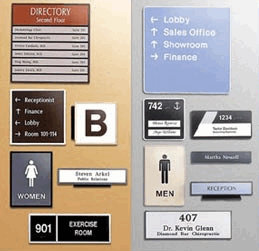Check out the Relevance of ADA Signs in Public Spaces
Check out the Relevance of ADA Signs in Public Spaces
Blog Article
Exploring the Trick Features of ADA Indicators for Boosted Access
In the world of availability, ADA signs serve as quiet yet powerful allies, making certain that spaces are comprehensive and navigable for individuals with specials needs. By integrating Braille and tactile components, these signs damage barriers for the aesthetically impaired, while high-contrast color systems and legible fonts provide to varied visual requirements.
Relevance of ADA Conformity
Guaranteeing conformity with the Americans with Disabilities Act (ADA) is critical for fostering inclusivity and equivalent accessibility in public spaces and offices. The ADA, passed in 1990, mandates that all public centers, companies, and transport services accommodate individuals with handicaps, guaranteeing they enjoy the very same civil liberties and opportunities as others. Compliance with ADA criteria not just fulfills legal responsibilities yet additionally enhances an organization's online reputation by showing its dedication to variety and inclusivity.
Among the essential elements of ADA compliance is the application of obtainable signs. ADA signs are developed to make sure that people with specials needs can conveniently navigate via buildings and spaces. These indicators need to stick to specific standards regarding dimension, typeface, shade contrast, and positioning to assure presence and readability for all. Properly implemented ADA signs helps get rid of barriers that people with disabilities frequently experience, thereby advertising their freedom and confidence (ADA Signs).
Moreover, sticking to ADA laws can minimize the danger of possible fines and lawful consequences. Organizations that fail to follow ADA standards may encounter claims or fines, which can be both harmful and economically burdensome to their public picture. Thus, ADA conformity is essential to promoting an equitable atmosphere for every person.
Braille and Tactile Aspects
The incorporation of Braille and tactile aspects right into ADA signage personifies the principles of ease of access and inclusivity. It is commonly placed under the matching text on signage to make sure that people can access the information without aesthetic support.
Responsive elements expand beyond Braille and include raised icons and personalities. These elements are created to be discernible by touch, enabling individuals to identify area numbers, toilets, leaves, and various other vital locations. The ADA sets specific guidelines regarding the size, spacing, and placement of these tactile components to enhance readability and make sure consistency across different environments.

High-Contrast Color Systems
High-contrast color design play a critical role in enhancing the visibility and readability of ADA signs for individuals with aesthetic impairments. These systems are necessary as they make the most of the distinction in light reflectance between text and background, ensuring that indicators are quickly noticeable, even from a range. The Americans with Disabilities Act (ADA) mandates using specific shade contrasts to accommodate those with restricted vision, making it an essential facet of conformity.
The efficacy of high-contrast colors depends on their capability to stand out in different lights problems, consisting of dimly lit atmospheres and locations with glare. Commonly, dark text on a light history or light message on a dark background is utilized to accomplish optimal contrast. For example, black message on a white or yellow history provides a plain aesthetic distinction that aids in fast acknowledgment and comprehension.

Legible Fonts and Text Size
When thinking about the style of ADA signs, the option of readable font styles and suitable text size can not be overemphasized. The Americans with Disabilities Act (ADA) mandates that fonts should be sans-serif and not italic, oblique, script, very ornamental, or of uncommon type.
The dimension of the text additionally plays a critical role in availability. According to ADA standards, the minimum text elevation need to be 5/8 inch, and it ought to enhance proportionally with viewing range. This is particularly crucial in public spaces where signage demands to be read quickly and accurately. Uniformity in message dimension contributes to a cohesive aesthetic experience, helping individuals in browsing environments successfully.
Moreover, spacing between lines and letters is integral to readability. Sufficient spacing avoids personalities from appearing crowded, improving readability. By adhering to these requirements, developers can considerably improve ease of access, ensuring that signs serves its designated objective for all individuals, despite their visual abilities.
Reliable Positioning Approaches
Strategic placement of ADA signage is vital for maximizing ease of access and making certain compliance with legal standards. ADA guidelines stipulate that indications must be installed at a height in between 48 to 60 inches from the ground to guarantee they are within the line of sight for both standing and seated people.
Furthermore, signs have to be put surrounding to the lock side of doors to enable easy recognition before entrance. Consistency in indication positioning throughout a facility boosts predictability, decreasing complication and enhancing total customer experience.

Verdict
ADA indicators play an important function in advertising availability by incorporating functions that attend to the requirements of individuals with impairments. These aspects jointly cultivate a comprehensive environment, underscoring the value of like this ADA conformity in making sure equal access for all.
In the realm of access, ADA signs serve as quiet yet effective allies, guaranteeing that spaces are inclusive and accessible for people with specials needs. The ADA, enacted in 1990, mandates that all public centers, companies, and transportation services accommodate people with specials needs, ensuring they delight in the same rights and chances as others. ADA Signs. ADA indications are designed to make certain that individuals with disabilities can conveniently browse via areas and buildings. ADA guidelines stipulate that signs need to be installed at a height in between 48 to 60 inches from the ground to ensure they are within the line of view for both standing and seated individuals.ADA signs play a vital function in advertising availability by integrating attributes that attend to the needs of people with disabilities
Report this page